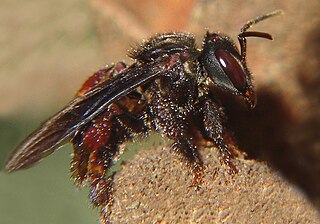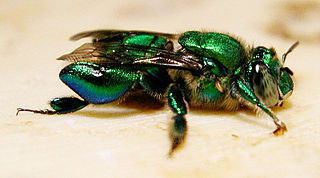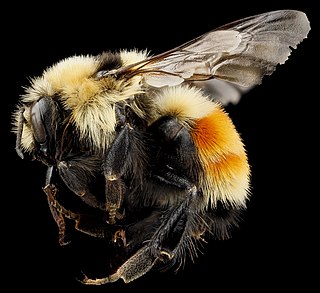
Bees are flying insects closely related to wasps and ants, known for their role in pollination and, in the case of the best-known bee species, the western honey bee, for producing honey. Bees are a monophyletic lineage within the superfamily Apoidea. They are presently considered a clade, called Anthophila. There are over 16,000 known species of bees in seven recognized biological families. Some species – including honey bees, bumblebees, and stingless bees – live socially in colonies while some species – including mason bees, carpenter bees, leafcutter bees, and sweat bees – are solitary.

Apidae is the largest family within the superfamily Apoidea, containing at least 5700 species of bees. The family includes some of the most commonly seen bees, including bumblebees and honey bees, but also includes stingless bees, carpenter bees, orchid bees, cuckoo bees, and a number of other less widely known groups. Many are valuable pollinators in natural habitats and for agricultural crops.

The subfamily Xylocopinae occurs worldwide, and includes the large carpenter bees, the small carpenter bees, the allodapine bees, and the relictual genus Manuelia.
Warwick Estevam Kerr was a Brazilian agricultural engineer, geneticist, entomologist, professor and scientific leader, notable for his discoveries in the genetics and sex determination of bees. The Africanized bee in the western hemisphere is directly descended from 26 Tanzanian queen bees accidentally released by a replacement bee-keeper in 1957 in Rio Claro, São Paulo in the southeast of Brazil from hives operated by Kerr, who had interbred honey bees from Europe and southern Africa.

The term cuckoo bee is used for a variety of different bee lineages which have evolved the brood parasitism behaviour of laying their eggs in the nests of other bees, reminiscent of the behavior of cuckoo birds. The name is perhaps best applied to the apid subfamily Nomadinae, but is commonly used in Europe to mean bumblebees Bombus subgenus Psithyrus. Females of cuckoo bees are easy to recognize in almost all cases, as they lack pollen collecting structures and do not construct their own nests. They often have reduced body hair, abnormally thick and/or heavily sculptured exoskeleton, and saber-like mandibles, although this is not universally true; other less visible changes are also common.

The Colletidae are a family of bees, and are often referred to collectively as plasterer bees or polyester bees, due to the method of smoothing the walls of their nest cells with secretions applied with their mouthparts; these secretions dry into a cellophane-like lining. The five subfamilies, 54 genera, and over 2000 species are all evidently solitary, though many nest in aggregations. Two of the subfamilies, Euryglossinae and Hylaeinae, lack the external pollen-carrying apparatus that otherwise characterizes most bees, and instead carry the pollen in their crops. These groups, and most genera in this family, have liquid or semiliquid pollen masses on which the larvae develop.

Apis laboriosa, the Himalayan giant honey bee, is the world’s largest honey bee; single adults can measure up to 3.0 cm (1.2 in) in length. Before 1980, Apis laboriosa was considered to be a subspecies of the widespread Apis dorsata, the giant honey bee, but in 1980 and for almost 20 years thereafter it was elevated to the rank of a separate species. It was classified once again as a subspecies of Apis dorsata by Engel in 1999, but was confirmed as a full species in 2020 on the basis of co-occurrence with Apis dorsata at many sites with no sign of interbreeding. It is highly adapted to its highland habitat in behavior.

A bee smoker is a device used in beekeeping to calm honey bees. It is designed to generate smoke from the smouldering of various fuels, hence the name.

Trigona is the largest genus of stingless bees, comprising over 80 species exclusively occurring in the New World, and formerly including many more subgenera than the present assemblage; many of these former subgenera have been elevated to generic status.

Bombus lapidarius is a species of bumblebee in the subgenus Melanobombus. Commonly known as the red-tailed bumblebee, B. lapidarius can be found throughout much of Central Europe. Known for its distinctive black and red body, this social bee is important in pollination.

Euglossa is a genus of orchid bees (Euglossini). Like all their close relatives, they are native to the Neotropics; an introduced population exists in Florida. They are typically bright metallic blue, green, coppery, or golden.

Exaerete is a genus of euglossine bees found from Mexico to northern Argentina. Like all orchid bees, they are restricted to the Neotropics. All but one species is metallic green, and they are cleptoparasites in the nests of other euglossines in the genera Eufriesea and Eulaema. It contains the following species:
Varroa sensitive hygiene (VSH) is a behavioral trait of honey bees (Apis mellifera) in which bees detect and remove bee pupae that are infested by the parasitic mite Varroa destructor. V. destructor is considered to be the most dangerous pest problem for honey bees worldwide. VSH activity results in significant resistance to the mites.
Heinrich Friese was a German biologist and entomologist, specialist of bees (melittologist). Between 1883 and 1939 he described 1,989 new species and 564 new varieties or subspecies of insects, 99% of which were bees.

Tetragonisca angustula is a small eusocial stingless bee found in México, Central and South America. It is known by a variety of names in different regions. A subspecies, Tetragonisca angustula fiebrigi, occupies different areas in South America and has a slightly different coloration.

Plebeia remota is a species of stingless bee that is in the family Apidae and tribe Meliponini. Bees of the species are normally found in a few states in southern Brazil and their nests can be found in tree cavities. Depending on the region, P. remota may have a different morphology and exhibit different behaviors. The bee's diet consists of nectar and pollen that are collected intensely from a few sources. Researchers have conducted a multitude of studies analyzing the changes that occur in the colony during reproductive diapause and what happens during the provisioning and oviposition process or POP.

Eufriesea surinamensis belongs to the tribe of euglossine bees and as such is a species of orchid bee. This should not be mistaken with the species group surinamensis, which includes Ef. surinamensis among other Eufriesea species.
Bombus bifarius, the two-form bumblebee, is a species of eusocial bumblebee of the subgenus Pyrobombus. B. bifarius inhabits mountainous regions of western North America, primarily the states of Colorado and Utah. Its common name refers to a historical artifact, in that it was believed that this species had a color polymorphism, with a red-tailed nominate form and a black-tailed nearcticus form, present in the species. This polymorphism has recently been shown to belong instead to a cryptic sister species, Bombus vancouverensis, that occupies almost the entirety of the range of what was formerly classified as bifarius; true bifarius only has a red form, so it is not "two-formed" at all.

Bombus huntii is a species of bumblebee. It is native to western North America, where it occurs in western Canada and the United States as far east as Manitoba and Minnesota, and in Mexico as far south as the Trans-Mexican Volcanic Belt. It is known commonly as the Hunt bumblebee or Hunt's bumblebee.

Triepeolus is a genus of cuckoo bees in the family Apidae. There are at least 140 described species in Triepeolus.















